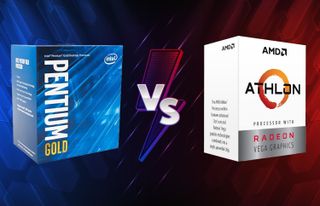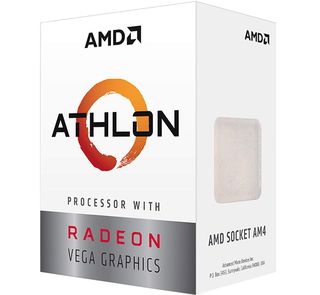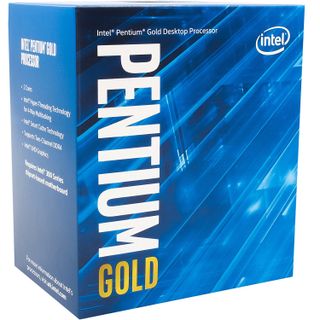AMD Athlon vs Intel Pentium: Which Cheap Chips Are Best?

It’s an age-old processor battle: AMD Athlon vs Intel Pentium. Twenty years ago—in the early days of Tom’s Hardware—those processor brands represented high-performance parts. Today, the Pentium and Athlon names are relegated to both companies' entry-level options, but the battle rages anew.
Modern Athlons and Pentiums are meant for lower-level computing tasks, such as light web browsing and word processing, not high-performance tasks like high-resolution gaming and video editing. If you're mulling over a new budget build and not sure which to choose, we'll break down the benefits and drawbacks of each below. Both Intel and AMD now deliver surprisingly capable budget chips. But in the end, a lot hinges on real-world pricing.
Features
At the high-end of the processor market, with its Ryzens and Threadrippers AMD counters Intel’s clock speed advantage by offering more cores per dollar than Intel. At the low-end, AMD’s big advantage is graphics processing.
| Row 0 - Cell 0 | Athlon 200GE | Athlon 220GE | Athlon 240GE | Pentium Gold G5600 | Pentium Gold G5400 | Ryzen 3 2200G |
| TDP | 35W | 35W | 35W | 54W | 54W | 65W |
| Architecture | Zen | Zen | Zen | Coffee Lake | Coffee Lake | Zen |
| Process | 14nm | 14nm | 14nm | 14nm++ | 14nm++ | 14nm |
| Cores / Threads | 2 / 4 | 2 / 4 | 2 / 4 | 2 / 4 | 2 / 4 | 4 / 4 |
| Frequency Base / Boost | 3.2 / - | 3.4 / - | 3.5 / - | 3.9 / - | 3.7 / - | 3.5 / 3.7 |
| Memory Speed | DDR4-2667 | DDR4-2667 | DDR4-2667 | DDR4-2400 | DDR4-2400 | DDR4-2933 |
| Memory Controller | Dual-Channel | Dual-Channel | Dual-Channel | Dual-Channel | Dual-Channel | Dual-Channel |
| Cache (L3) | 4MB | 4MB | 4MB | 4MB | 4MB | 4MB |
| Integrated Graphics | Vega 3 (3 CU) | Vega 3 (3CU) | Vega 3 (3 CU) | UHD Graphics 630 | UHD Graphics 610 | RX Vega 8 (8 CU) |
| Unlocked Multiplier | No | No | No | No | No | Yes |
| MSRP | $55 | $65 | $75 | $86 | $64 | $99 |
Intel Pentium Gold and AMD Athlon processors all come in dual-core configurations. Pentium chips feature Intel’s Hyperthreading technology, and Athlon processors support Simultaneous Multi-Threading (SMT), giving both companies four logical threads to work with.
The 3.7 GHz Pentium G5400 and the 3.9 GHz Pentium G5600 have a distinct clock speed advantage over the 3.2 GHz, 3.4 GHz, and 3.5 GHz Athlon processors.
AMD’s chips make up for their clock speed deficit with other features, such as the Radeon Vega-based graphics engine that's composed of three Compute Units (CUs), serving up a modest 192 Stream processors, 12 TMUs, and four ROPs.. The Pentium CPUs also have built-in graphics processors, but Intel’s UHD Graphics 630 (G5600) and UHD Graphics 610 (G5400) are limited to 24 and 12 execution units, respectively.
AMD’s Athlon processors also support faster memory than Intel’s latest Pentium chips (DDR4-2667 vs DDR4-2400). And they draw less power than Intel’s counterparts (35w vs 54w).
Stay on the Cutting Edge
Join the experts who read Tom's Hardware for the inside track on enthusiast PC tech news — and have for over 25 years. We'll send breaking news and in-depth reviews of CPUs, GPUs, AI, maker hardware and more straight to your inbox.
Winner: AMD. Clock speed isn’t everything. Especially when you’re on a budget, AMD’s Athlon processors support faster memory (a boon for integrated graphics), draw less power, and they include Vega GPU cores for moderate video tasks.
Overclocking
Typically, when you think about a budget processor and the features it would offer, overclocking doesn’t usually come to mind. Of course, there are some significant historical exceptions—Intel’s Celeron 300A brings back memories—but overclocking is typically a feature reserved for higher-priced components.
In recent years, overclocking has become much more mainstream. And as such, AMD has embraced the feature across almost its entire product stack. However, the Athlon series is the outlier. AMD does not officially support overclocking the new Athlon processors, but that didn’t stop motherboard manufacturers from supporting the feature anyway.
Asus, Gigabyte, and MSI all offer motherboards that enable you to adjust the clock speed of Zen-based Athlon processors. You can’t improve the clock speed of the built-in GPU, and memory is locked down to DDR4-2667, but with the right motherboard you can coax 3.9GHz out of an Athlon processor. In our experience, all three Athlon models top out at the same clock speed, so if you’re going to overclock, you might as well save some money and get the Athlon 200GE. You can also overclock with the stock cooler, which is a great value-add.
Intel’s Pentium processors do not support overclocking, and you won’t find a motherboard that overrides Intel’s specifications.
Winner: AMD. AMD is the clear winner for the overclocking category, because you can’t overclock a Pentium processor. AMD didn’t want to enable overclocking, but with the right motherboard, you can do it anyway. The moderate clock speed increase doesn’t improve performance dramatically, but if you overclock an Athlon 200GE, you can yield the same performance as an overclocked Athlon 240GE, which reinforces its substantial value.
Cooling Requirements
AMD’s Athlon 200GE, 220GE and 240GE dual-core processors feature an Low 35W TDP. In other words, they don’t require substantial cooling hardware. AMD equips the Athlon lineup with a heatsink and fan combo with ample capacity to dissipate the nominal heat output from these low-powered chips.
We even found that the stock cooler provided enough cooling capacity to keep our samples at safe temperatures even with the maximum overclock applied.
Intel’s Pentium Gold processors also come bundled with an Intel heatsink and fan assembly, and there’s really no reason to bother upgrading that cooler except aesthetics. Pentium chips have a higher TDP rating than AMD’s Athlon processors, but you can’t overclock them, so they’ll never exceed the factory specifications.
Winner: Tie. AMD and Intel both give you everything you need to keep their entry-level processors cool enough for safe operation.
Motherboard Options
Intel’s Pentium processors can’t be overclocked, but that doesn’t mean that they lack motherboard options. On the contrary, the lower down Intel’s lineup you go, the more motherboard options you get.
In some ways, it’s easier to shop for a motherboard for a high-end build because right off the top you’ll eliminate the low-end chipsets and focus on the feature-rich Z-series. And if you’re shopping for a moderate-budget gaming system, you may consider an H370.
When you’re building a system around a Pentium processor, Intel’s entry-level H310 will give you everything you need for a basic system. However, the 5000-Series Pentium G processors share the same socket as Intel’s current-generation Core processor. So, if you have any inclination to upgrade your CPU down the road, you can save yourself a few bucks later by picking a motherboard with a better chipset today.
Intel Chipsets
| Intel | Chipset | Supported Processor PCI Express Port Configurations | USB Revision | Max Number of SATA 6.0 Gb/s Ports | Intel Optane Memory Support | Supports Overclocking |
| Enthusiast | Z390 | 1x16 or 2x8 or 1x8+2x4 | 3.1/2.0 | 6 | Yes | Yes |
| Enthusiast | Z370 | 1x16 or 2x8 or 1x8+2x4 | 3.0/2.0 | 6 | Yes | Yes |
| Mainstream | H370 | 1x16 | 3.1/2.0 | 6 | Yes | No |
| Mainstream | Q370 | 1x16 or 2x8 or 1x8+2x4 | 3.1/2.0 | 6 | Yes | No |
| Mainstream | B360 | 1x16 | 3.1/2.0 | 6 | Yes | No |
| Mainstream | H310 | 1x16 | 3.1/2.0 | 4 | No | No |
AMD’s new Athlon processors are also compatible with the company’s full line of motherboards (save for HEDT/Threadripper), including boards with 300-series and 400-series chipsets. The A320 chipset is perfect for a low-budget build, but if you want to overclock your processor, you’ll need something a little bit more advanced.
AMD doesn’t officially support overclocking the Athlon series, but some motherboard manufacturers have released firmware that unlocks some parameters of the Athlon chips. If overclocking is on your radar, you’ll need to look at boards with the a chipset greater than A320.
AMD Chipsets
| AMD | Chipset | PCI Express Graphics | USB 3.1 G2 + 3.1 G1 + 2.0 | SATA + NVME | SATA RAID | Supports Overclocking |
| Enthusiast | X470 | 1x16/2x8 (AMD Ryzen processors) 1x8 (A-Series/AMD Athlon processors) | 2+10+6 | 6 + x2 NVMe (or 4 SATA plus 1 x4 NVMe on AMD Ryzen™ Processor) | 0,1,10 | Yes |
| Enthusiast | X370 | 1x16/2x8 (AMD Ryzen) 1x8 (A-Series/AMD Athlon) | 2+10+6 | 6 + x2 NVMe (or 4 SATA plus 1 x4 NVMe on AMD Ryzen™ Processor) | 0,1,10 | Yes |
| Performance | B350 | 1x16(AMD Ryzen)1x8 (A-Series/AMD Athlon) | 2+6+6 | 4 + x2 NVMe (or 2 SATA 1 x4 NVMe on AMD Ryzen™ Processor) | 0,1,10 | Yes |
| Mainstream | A320 | 1x16 (AMD Ryzen) 1x8 (A-Series/AMD Athlon) | 1+6+6 | 4 + x2 NVMe (or 2 SATA 1 x4 NVMe on AMD Ryzen™ Processor) | 0,1,10 | No |
Winner: Tie. AMD and Intel both offer budget-friendly options that pair well with their low-end processors. And if you’re looking for fancy features, both processors are compatible higher-end options as well.
Gaming Performance











When it comes to gaming performance on integrated graphics (above), the choice between AMD’s Athlon lineup and Intel’s Pentium lineup isn’t as clear as you might imagine. AMD’s Vega GPU cores give standalone Athlon processors a significant advantage over standalone Pentium processors.
The three Vega cores found in the Athlon chips can pump out reasonable frame rates in a handful of popular games—provided the resolution and detail settings are dialed back, whereas the UHD Graphics cores in the Pentium chips can barely handle Dota 2.











That said, if you’re going to be pairing your system with a discrete graphics card, you should turn to Intel. In our experience, even an overclocked Athlon can’t deliver data to the GPU fast enough to keep up with the Pentium G5400.
Above, we've tested the chips paired with an Nvidia GeForce GTX 2080 at the 1920x1080 resolution to remove any GPU limitations. We tested with an Nvidia GeForce 1080 FE graphics card to remove graphics-imposed bottlenecks, but the difference between the processors will shrink with the cheaper graphics cards that are commonly found in budget builds.
Winner: Tie. AMD’s Athlon processors offer better out-of-the-box gaming performance than Intel’s Pentium lineup, unless you pair them with a discrete graphics card. Intel’s clock speed advantage and its superior number of instructions per clock (IPC) give the Pentium chips a leg up when paired with a dedicated graphics card.
Productivity Performance






















AMD gives Intel a run for its money in the gaming and features categories, but Intel is still the king of productivity on the low end.
Intel’s Pentium processors are surprisingly strong in Adobe Creative Cloud applications. In Illustrator, the Pentium G5400 and G5600 outperformed our Athlon 240GE, Ryzen 3 2200G and Ryzen 3 1300X processors, while they were clocked at 3.9 GHz.
The overclocked Athlon is faster than the Pentium G5400 in After Effects. But the Pentium came out on top in every other Adobe test.
Intel’s processors are also stronger than AMD’s in our web browser test suite, they perform better in spreadsheet work, and Pentium chips are quicker at starting applications than AMD chips.
However, the Athlon 220GE and Athlon 240GE outperformed the Pentium chips in our PCMark 10 photo editing test.
Winner: Intel. Intel’s Pentium processors are better than AMD’s Athlon processors in almost all the productivity tests we put them through. The performance difference between the two processor types isn’t dramatic, but Intel is superior for these tasks.
Rendering








In Cinebench, PCMark 10, POV-RAY, and Corona 1.3, all three of AMD’s processors return the lowest scores in our test lineup. Overclocking our Athlon 240GE to 3.9 GHz improved the scores a little bit, but it only outperformed the two Pentium options in Cinebench multicore and POV-RAY multicore.
If you work with Blender, the Athlon’s fare better than the Pentium chips. But if we’re honest, if you’re looking for a computer to do video rendering with, we would highly recommend looking at stronger CPU options. Neither Intel’s Pentium nor AMD’s Athlon series are well suited for this type of workload.
Winner: Intel. Except for in Blender, Intel’s Pentium lineup is superior to the Athlon lineup at video rendering. That said, being better than the worst isn’t great. Don’t buy a Pentium processor for video rendering.
Encoding and Compression








Like video rendering, budget processors aren’t well suited for encoding and compression work. However, in this case, AMD’s processors might be a better option than Intel’s.
AMD’s Athlon 200GE is the worst performer of the lot, across our entire suite of tests except for Y-Cruncher. However, our overclocked Athlon 240GE outpaced Intel’s Pentium processors in most of our tests.
The Pentium chips are stronger at 7-zip compression, but the overclocked Athlon is far better at 7-zip decompression than the Pentium options. The tuned Athlon also topped the Pentium chips in our LuxMark, LAME, and Handbrake tests.
Winner: AMD. The budget CPUs from Intel and AMD are not great choices if you do a lot of encoding or work with compressed files regularly. Intel’s options are better at the stock operating clock speeds. However, if you overclock an Athlon processor, you can squeeze out more performance than Intel’s offerings.
Value Proposition
Intel is really feeling the pressure from AMD these days. For years, AMD struggled to compete with Intel, but in the last two years the company has been turning up the heat. AMD’s Ryzen lineup took a substantial chunk of Intel’s market share, and the Athlon lineup is poised to help AMD continue that trend.
Intel is in a tight spot because it’s dealing with record demand coupled with production constraints that have wreaked havoc on the company’s ability to supply enough silicon to meet demand. As such, Intel’s processors have been creeping up in price.
What was once a $64 processor, the Pentium Gold G5400 now sells for around $100. And the Pentium Gold G5600, which launched at $86 MSRP now sells for over $140. And that's if you can find them in stock.
AMD’s latest Athlon processor, meanwhile can currently be found for less than its $75 MSRP.
Winner: AMD. Intel’s processors would be much more competitive at their suggested retail prices. But with the current supply problems, Pentium processors are trading at more than 30 percent markup, which makes AMD’s Athlon series a much-better value.
Bottom Line
AMD is really shaking up the CPU market from top to bottom, especially now that Intel is having trouble with its production volume. Where Intel’s processors are going up in price and getting harder to find, AMD’s competing chips are readily available and more affordable.
Honestly, we can’t think of many reasons to buy a Pentium Gold over a new Athlon unless you’re shopping for PCs for an office. Pentium processors are superior for basic productivity tasks, but not much else at this point except for rendering, which you really shouldn't be doing on a dual-core budget processor anyway.
Combine that with the higher prices of Intel's budget chips, which are at times more than double what AMD is charging for its recent Athlons, and there's really not much of a contest here at the moment. Of course Intel knows this, which is likely why we've seen indications that new Pentiums are coming, including a possible model with an impressive 4GHz clock speed. The real question, if and when these chips arrive, will be pricing and whether Intel can keep them in stock.
| Round | Intel | AMD |
| Features | Row 1 - Cell 1 | ✗ |
| Overclocking | Row 2 - Cell 1 | ✗ |
| Cooling Requirements | ✗ | ✗ |
| Motherboards | ✗ | ✗ |
| Gaming Performance | ✗ | ✗ |
| Productivity Performance | ✗ | Row 6 - Cell 2 |
| Rendering | ✗ | Row 7 - Cell 2 |
| Encoding & Encryption | Row 8 - Cell 1 | ✗ |
| Value | Row 9 - Cell 1 | X |
| Total | 5 | 7 |
Want to comment on this story? Let us know what you think in the Tom's Hardware Forums.
MORE: Best Cheap CPUs
MORE: CPU Benchmark Hierarchy
Kevin Carbotte is a contributing writer for Tom's Hardware who primarily covers VR and AR hardware. He has been writing for us for more than four years.
Most Popular










